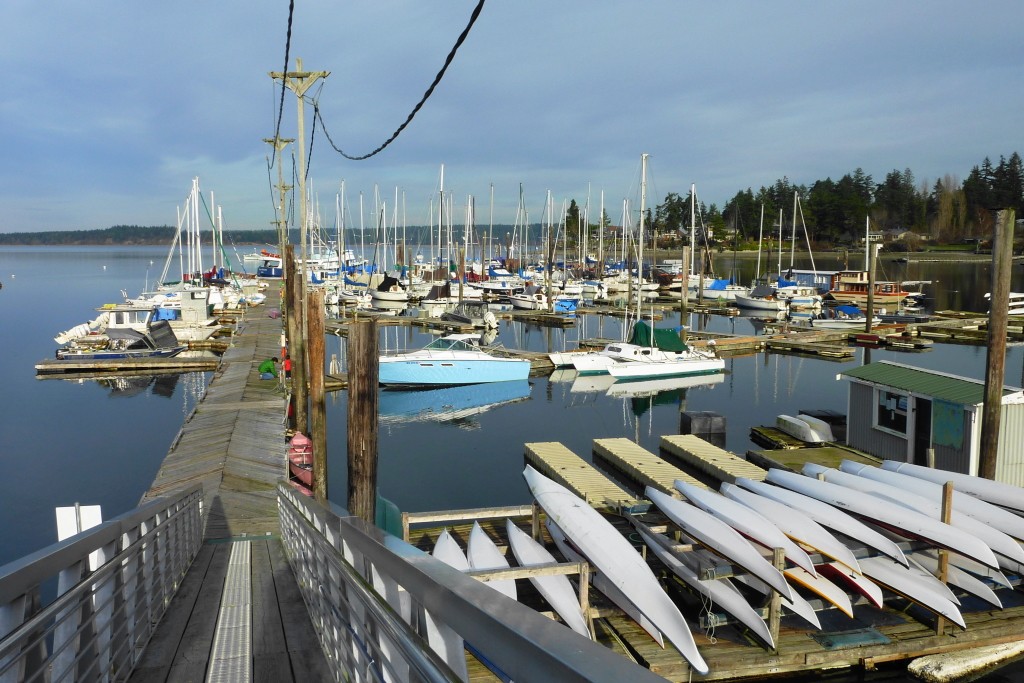By Kate Scriven
 I live in Boston Harbor. However, I could just as easily be living in Doffelmeyer Point, Harriman City, or Port Olympic as these are all names that Boston Harbor held prior to the current one. Whatever the name, I couldn’t imagine living anywhere else.
I live in Boston Harbor. However, I could just as easily be living in Doffelmeyer Point, Harriman City, or Port Olympic as these are all names that Boston Harbor held prior to the current one. Whatever the name, I couldn’t imagine living anywhere else.
The Boston Harbor area can be loosely defined as the point extending north of downtown Olympia between Budd and Henderson Inlets. Our southern border, for our elementary school at least, is 36th Avenue NE. With rural roots intact, the area still includes many farms and homes are typically set on no less than one acre and typically more (with the exception of the Marina proper). Despite our rural feel and large lots, we live less than 10 minutes from downtown Olympia, a feature that has kept the area desirable even through the tough real-estate market. But more than the land features, I love the community that I have become a part of in my 11 years as a Boston Harbor resident. With several hubs of activity – the school, the “Merc”, the Marina – relationships are built and families stay generation after generation.
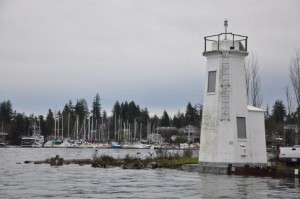
A Historical Hot Commodity
Since the 1860’s, Boston Harbor has been loved. Pioneers first staked claims to “The Point” when Isaac Dofflemyer made a 320-acre donation land claim from the point, renamed Dofflemyer Point, southward to the current site of Burfoot Park. Dofflemyer erected a “lighthouse” in 1887, marking the entrance to Budd Inlet. The original was simply a Kerosene lantern on a tall pole, which Isaac and his wife Susan operated and cleaned. It was later upgraded to a lens-lantern and was cared for by Dofflemyer’s son, Cyrus and his wife Minnie. After many years, the wooden structure burned and was replaced by the new 30-foot pyramidal concrete lighthouse. First lit in 1934, the lighthouse was added to the National Register of Historic Places in 1995. Visitors are still welcome at the Lighthouse today.
Despite the idyllic story of the Lighthouse, the early 1900s were a very volatile time in the area. Several shady promoters attempted to create “booming metropolises” on the point. The first of these was P.P. Carroll in 1904. A newspaperman and lawyer, Carroll dreamed of a seaport with long wharfs to supply sawmills and brick and tile factories. The new port was to be named Harriman City in honor of the president of the Southern Pacific and Union Pacific railways who had promised to bring the terminus of the rail lines to the area. “Port Olympic” began being platted, however, savvy South Sound citizens saw through the shady financing and knew that the “port” was mostly mudflats at low tide and the scheme failed.
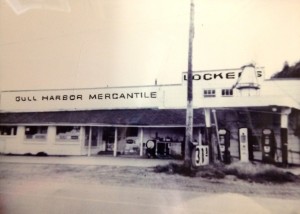
In 1907 a second, more experienced (and even shadier) promoter came on the scene. C.D. Hillman, notorious still in the area, promised people a prosperous and tranquil city at the point and, modeling his plans after the eastern city, named it Boston Harbor. A media blitz from Seattle to Olympia ensued and boats were chartered to bring wealthy prospective buyers for “a big clam bake and barbecue on the beautiful grounds of Boston Harbor. Two fruit orchards of ripe fruit thrown open to the public. A band will furnish music.”
More than 2,000 people arrived that October day and in the frenzy, the platted lots in the Harbor (now the Marina neighborhood) all sold. C.D. Hillman’s salesmen lured buyers with “easy terms” and single lots were sold to multiple buyers. However only the first to arrive at the main office and record the contract got the land, resulting in a lot of cash being pocketed by Hillman.
Over the following months, grand plans and enormous sums of investment capital were publicized throughout the area. But, in 1911 Hillman was arrested and brought to trial on 13 counts of fraud in connection to the fantastical claims made in his brochures for Boston Harbor. He was convicted and served two and a half years in jail. The promotion failed and the community continued on as the rural enclave it had been since the 1860s.
Over the years, the area saw several other attempts at development, but it remained largely rural. In the 1920s the Marina was built and the area saw growth with summer cabins and small resort areas. More residents located onto inland acreage in the 1960s and 70s, but it wasn’t until the mid-1980s that growth picked up in the Marina area. Working with Thurston County, the residents were finally able to install water and sewer infrastructure, allowing for more construction. Many small cabins were torn down and today’s permanent homes were built.
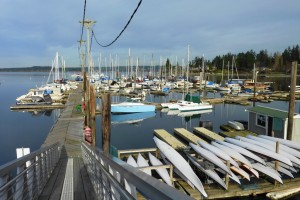
Boston Harbor’s Community Hubs
Today, Boston Harbor retains its quiet, rural feel. Yet, with modern transportation and expanding suburbs, we are now rather “close” to downtown when compared with other areas. Most residents love the neighborhood for the tranquility and the closeness bred, surprisingly, from our isolation from one another on large parcels. There are no sidewalks or cul‘d sacs to gather and chat. As a result, we rely on the hubs of our community to build our relationships.
Chief among those are the Boston Harbor Marina, the Gull Harbor Mercantile (or “The Merc”) and Boston Harbor Elementary School. These serve as neighborhood gathering spots as well as hubs of information about the goings-on in the area.
If there is something happening, chances are, they know about it at The Merc. The Gull Harbor Mercantile is a country general store in every sense. With gas, quality groceries, movies, mailing services, espresso and – yes – hardware, chances are strong that if you need it, you’ll find it there. On a recent trip, my husband purchased a replacement gasket for an outdoor hose faucet, organic milk, gluten-free beer, and a card for his mother. Purchased in 1957 by Edwin and Beryl Kuhr, the store has remained in the family, being run by daughter Terri Kistler and her husband Dick until July of 2012 when their son Ted took over day to day operations. Throughout the years, there remains a constant truth at The Merc – friends gather, neighbors meet, goods are bought, and community is built.
The Boston Harbor Marina, in similar fashion, serves as a gathering place for residents and visitors alike. As the only gas dock in the area, many boaters have discovered the charms of our little Marina. The store offers wine and beer, ice cream and snacks. A well-stocked seafood counter has fresh shellfish and salmon for most of the year and all can be enjoyed on the welcoming deck’s chairs or picnic tables. The public boat launch is directly adjacent and kayaks are available for rental as well. The Boston Harbor Association sponsors a “3rd of July” Fireworks show in the Marina, echoing a tradition started in 1922 with Walt Drehmel’s Firecracker Dance, held at his Boston Harbor dance hall. Drehmel’s descendants still live in the marina area and have championed the celebration of Independence Day for over nearly 100 years.
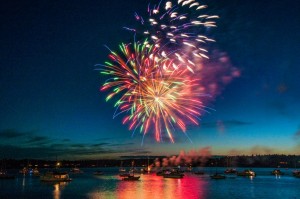
The third important hub in the area is Boston Harbor School. Since the late 1800s, there has been a school in some form in the area. In 1938, the larger school was established at the current site on Zangle Road. The small schoolhouse was added to over the years including a large brick building in the 1960s. In 1990, the current school was built and the small “white building,” which was the original 1938 school house, was sold for $1 to Mike Grady and moved to its current location on 72nd avenue. It is still used to host yoga classes and community gatherings and its old chalkboards and coat closets remain intact. The current school is characterized by strong parent support, a close-knit staff including many Boston Harbor residents, and a continuation of the community feel that is so prevalent throughout the area.
With a rich and long-standing history, Boston Harbor is a neighborhood steeped in traditions and multi-generational residents. Forty year local and historian Pam Trautman, who helped me extensively with information on the area’s history, sums it up well. “Part of the reason that this history is still celebrated is that there has always been a sense of community, even when it was just small little cabins out here. I think that has filtered down through the years. We know our neighbors and we care for each other and that makes a community.”
Join the fun in Boston Harbor this summer by visiting Burfoot County Park, attending the 3rd of July Fireworks show, the Boston Harbor Garden Tours and Plant Sale on June 23rd, or sipping a brew on the Marina docks. While we might be a tight-knit group, we love nothing more than sharing our love of Boston Harbor with others.







































